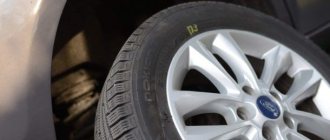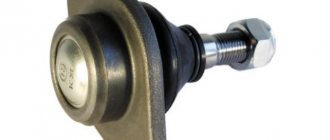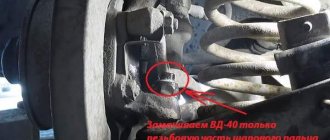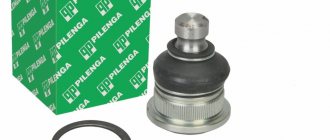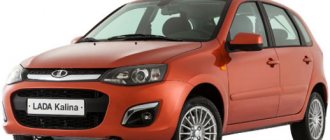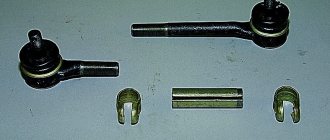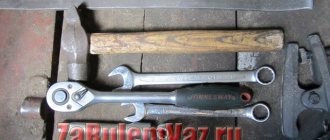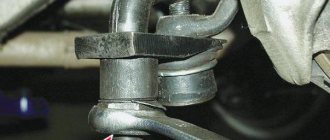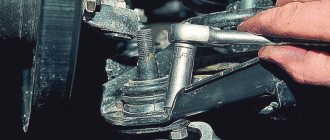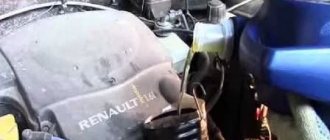If ball joints squeak when moving, this is often caused by the absence or lack of lubrication under the boot of this hinge joint. This happens due to a ruptured boot. In rare cases, an insufficient amount of lubricant is installed in production. In order for ball joints and steering ends to last their entire service life, they must be maintained. Beginning car owners often do not know how to take care of the chassis and what kind of lubrication is needed for ball joints. Today we will try to answer this question.
Do ball joints and tie rod ends need to be lubricated?
There is an opinion that it was necessary to process these compounds earlier in the days of the classic models of VAZs, Moskviches and other automobile industry from the USSR, but now it is not necessary to do this. To figure out whether these parts need maintenance, you need to understand how ball parts are designed.
The device may vary. But the design necessarily includes a ball joint and a pin. The base is used as a hinge stop. The top of the support is covered with anther.
During operation, the hinge constantly shifts and moves. This contributes to its accelerated wear. During operation, lubricant is produced. And if the car sits for a long time, the lubricant may dry out. In addition, if there is no lubricant for the ball joints in the space between the base of the unit and the boot, then dirt will form there. It not only accelerates wear, but also causes poor joint performance. If knocks and squeaks appear in the ball joints, this is an alarm bell.
In order not to subject the ball joint mechanism to accelerated wear, it is necessary to fill the free space under the boot with lubricant. But you also need to know what kind of lubricant to use for ball joints so that these units work as long as possible.
An easy way to extend your life
It can be applied not only to new parts, but it can be used on old ones, provided that they are still operational and do not have much play. It is advisable to do this after purchase and before installing a new support, this guarantees an increase in operating time.
Carefully remove the lower retaining ring of the boot. Use a screwdriver to pry it up and take it out in a circle. The most difficult thing is to pry it off, because its end fits tightly to the rubber.
When removing, be careful not to damage the protective rubber cover, also known as the boot. Cuts on it allow moisture to enter the rubbing elements of the spare part, causing them to fail.
Remove the boot from your finger. We inspect the presence of lubricant under it. As practice shows, the manufacturer skimps on adding it in sufficient quantities. In most cases, it will be a maximum of 2 grams, this is not enough for long-term operation of ball joints.
Add lubricant so that it completely fills the space between the pin ball and the liner (body). We are developing the support so that more lubricant gets inside the housing. We put another portion under the boot itself and put it on.
The amount of lubricant should not be too much. This is the moment when excess will only do harm. We added and put on the boot, if it fits on freely and it still has some compression left, then you guessed right. If it is completely clogged, then the excess will tear it as it works.
We put the boot in place. Install the retaining ring from the bottom and if it was on top. We check their fit so that they fit exactly into their grooves and the protective cover does not come off the hinge.
It is recommended to place a tighter ring on the top of the boot. You can take it from the seal of the washing machine, cutting it to size. Remember, it should not cut the rubber of the casing with its edges.
If there is no top ring, we use improvised means. The grandfathers used a wide nylon rope, wrapping it tightly around the boot. In this case, you need to use a wide rope; a narrow one can cut the rubber.
There are no synthetic threads, it is advised to take a fuel hose of a suitable internal diameter, preferably 1-2 mm smaller. We cut a ring three millimeters wide from it, stretch it a little with screwdrivers and put it on the boot. It will press it tightly to your finger, moisture will not get under it, increasing its service life.
For example, on Lemforder ball joints, by removing the protective cover, you can find holes in the pin ball. Using a medical syringe, you can fill them with lubricant, the old one will come out, and the new one will replace it. To make it easier to squeeze out the syringe, you need to heat the tip of the needle with a burner.
When should ball joints and tie rod ends be treated?
The ball joint is lubricated at the factory before installation on the vehicle. But when it comes to domestic cars, this requirement is not always met. In addition, during the operation of the car, the hinge constantly moves. Accordingly, lubricant is constantly consumed. Therefore, the node must be processed constantly, at certain intervals. But how can you tell when your ball joints need new grease?
All problems associated with ball joints, even in the early stages, can be easily determined by ear. But for serious problems, modern diagnostics can help. The first signal that indicates that the lubricant has run out is squeaks and knocks while the car is moving. If these sounds come from the places where the ball joints are installed, then these units are checked first. If there are no serious plays in the hinge, then regular maintenance of the element will help extend its service life.
What determines the service life
First of all, from the driving style. The more aggressive the driving, the more the suspension components suffer. They bear more load and fail faster.
While working at a service station, I noticed that more often reckless drivers came to replace ball joints and drive according to the principle: “The higher the speed, the fewer potholes.” Older people and those who take care of their cars stopped by for repairs less often.
Bad roads. Everything is clear here; if a wheel falls into a hole, the load on the hinges increases. The higher the speed, the more forces act on the part. These forces want to tear the finger out of the support cage; it’s hard to argue with physics.
Low quality of spare parts . The desire to reduce the cost of parts leads to savings on materials. Cheap boots made of low-quality rubber are installed. A minimum of lubricant is placed between the ball and the polyurethane liner; in some cases it simply isn’t there.
This trend is observed not only among cheap manufacturers; expensive parts also suffer from this problem. The second principle works here - why make a durable spare part if you can shorten the service life and the buyer will come again in the near future for a new component.
The review “The Best Ball Joint Companies” looked at manufacturers of quality spare parts that you should pay attention to before purchasing a new joint. It is recommended that you carefully read the list presented, with the advantages and disadvantages of their products. The use of spare parts from these companies will guarantee long service life of the components.
Signs of ball joint failure
You can tell that the ball joints have run out of lubrication by knocking noises when driving over uneven surfaces. Also, if you need to lubricate the steering tips, you may hear a squeak when turning the steering wheel.
He may talk about the need to replace the lubricant in the balls. If the car does not maintain a straight path and the wheels constantly wobble, this also indicates worn ball joints. Tires that wear unevenly also indicate breakage or wear.
Lubrication (injection) of silent blocks with lithol
Litol, CV joint, pennant, as well as imported multi-component lubricants designed specifically for ball joints, bearings and friction units, which contain metal-clad compounds that make it possible to minimize friction between parts and maximally protect the metal surface from corrosion and wear, the latter is achieved by using as part of lubricants of fine metal powders, oxides and other compounds that cover the surface of metals with a thin protective layer that is resistant to wear and corrosion. It is these lubricants that are used in ball joints, CV joints, bearings and ball joints, which include floating rear suspension silent blocks with passive steering.
What to lubricate with?
And so, a novice car owner hears characteristic squeaks and realizes that it’s time to service the ball and steering joints. But since beginners do not have much experience, they are concerned about the question of what kind of lubricant is needed for ball joints and steering ends.
Let's try to answer this question. Lithium-based lubricants are often used for such hinge joints. These compounds can withstand the high loads that the hinge experiences during operation. You also need to know how to choose the right product.
Oil injection into the ball
My 45 creaked mercilessly
You inject oil with an ordinary syringe with a needle and forget about the ball ones, the same garbage was squeaking, I came to Uncle Vanya to change it, he tells me they are normal, they just dried up, I injected them and in reality I forgot about them, I drove a hundred thousand and sold the car.
Added after 15 minutes The balls went one 20, the other 25. They creaked like an old cart. I added lubricant with a needle through the boot, and changed it in the spring at 33,000 miles. I installed the original Belmagovsky ones in Lada packaging. I changed the steering tips at 47k. There were still alive, 5-10 thousand could still travel. I changed it because changing it in winter without a garage is not an option. A resource of these parts of 40-50 thousand would suit me perfectly
Something happened very little.
Well, liquid, probably motor, or whatever is available. NOT SUNFLOWER AND NOT OLIVE.
It rattled like a blacksmith in a forge, even visually the play is noticeable. I bought again tracks with a silicone case, by all indications they are original. It seems like they don’t install a track with silicone at the factory, why again?
90k on the previous 99. And the standard ones, yes, with a regular rubber boot made by xs who.
Message from MARAT1983 https://www.lkforum.ru/ladakalina/buttons/viewpost.gif (https://www.lkforum.ru/showthread.php?p=5464296#post5464296) You inject oil with a regular syringe and needle and forget about balls
And what oil? Under Soviet rule, the injection into the ball was made with ordinary castor oil, after heating it in warm water. I saw recommendations to inject TAD-17, as well as nigrol diluted to the desired consistency with working out.
Message from MARAT1983 https://www.lkforum.ru/ladakalina/buttons/viewpost.gif (https://www.lkforum.ru/showthread.php?p=5464296#post5464296) You inject oil with a regular syringe and needle and forget about balls
And what oil? Under Soviet rule, the injection into the ball was made with ordinary castor oil, after heating it in warm water. I saw recommendations to inject TAD-17, as well as nigrol diluted to the desired consistency with working out.
The day before yesterday we injected the VAZ 2110 with regular motor oil, now it was quiet, but it creaked like a cart.
The day before yesterday we injected the VAZ 2110 with regular motor oil, now it was quiet, but it creaked like a cart.
At the same time, diagnostics are carried out; now it is known for certain what was creaking. People, I read recommendations to inject oil into ball joints and steering ends periodically for prevention once or twice a year (when changing wheels). They say that with such care, the balls can last up to 100 thousand. Or maybe it would be better to remove them and fill them with lithol? Your opinion?
Or maybe it would be better to remove it and fill it with lithol? Your opinion?
After removing and installing the balls, the wheel alignment will have to be adjusted. And even more so for steering tips.
denisl56, BigKot, Martian, GenaM,
You are all absolutely right. I expressed my opinion, everyone decides for themselves. For some, microns do not matter, but for others it is important. I finished.
Do they change everything at once or just the lower ones usually?
Where do the upper ball joints come from on Kalina? Do not confuse with "classics".
If there is a squeak, it makes sense to remove the ball joint for diagnostics.
82,000 km, a creaking sound began to appear, like on an old sofa, when braking, always and often when starting from a stop, as well as when driving over strong bumps.
I'm 90% sure that the problem is in the balls. Which 2108 or 2110 would you recommend, are they different, and which company is better to buy?
Does it make sense to try an injection with motor oil?
PS: I changed the air flow sensor a week ago, minus 3000 rubles from the budget, minus 500 rubles for rear pads and other little things
Added after 34 seconds, when replacing ball joints, is it necessary to do a wheel alignment? Everyone here has their own religion. I do not
I paid 300 rubles for replacing 2 ball joints. I wanted to buy BelMag, it was not in the store.
We recommended the company RosAvtoSport for ball B2, a set of 550 rubles, it says reinforced on the box. Bought.
In short, I don’t know how long they’ve been leaving. Photos will come later. I’m writing from my phone.
Source
What is special about lithium greases?
In terms of their composition, lithium-based materials are substances derived from petroleum oils. During the production process, the oils are thickened by adding lithium soap. This makes it possible to obtain the desired consistency. At the same time, petroleum oils in combination with fatty acids contained in lithium soap also have an additional preservative effect. Car owners in practice use several types of lubricants based on this base. They differ from each other in the percentage of oil and lithium soap, as well as the content of various additives. Well, let's look at them in more detail.
Manufacturers ShRB-4
In the Soviet years, the production of lubricants was carried out exclusively by the Berdyansk Experimental Oil and Oil Plant, which, after the collapse of the USSR, became the Azmol Public Joint Stock Company, located outside the Russian Federation. Now this enterprise is called AZMOL British Petrochemicals (AZMOL British Petrochemicals).
In the Soviet Union, ointment for CV joints was not in particularly great demand for two reasons. Firstly, the number of cars owned by citizens was much smaller than at present.
Secondly, thanks to the durability of the lubricant, one can of ointment was enough for each car owner for a long time, so there was no need to buy it often.
Today, ShRB-4 lubricant is produced in Ukraine by the above-mentioned Berdyansk enterprise under the Agrinol brand, packaged in 400-gram jars.
In Russia, the production of ShRB-4 is carried out, located in the village of Starosyrovo in the Novomoskovsky administrative district of Moscow. This company packages the product in cans of twice the volume - 0.8 kg each.
"Litol-24"
This is the most common lubricant for ball joints and steering wheels among car owners. And there are several reasons for this. The first reason is that this lubricant operates in a wider temperature range, which makes it possible to use Litol in any climatic zone.
Due to the presence of stabilizing additives, this lubricant can serve for a fairly long period of time. The composition reliably protects metal rubbing parts from negative destructive influences. You also need to not be afraid of temperature changes. There is no need to worry that when moving through water or snow, a ball lubricated with Litol will lose protection.
Examples from the experience of car owners
“If you have a Lada Granta, lubricating the ball joint is not so easy. It's all about the boot, which compresses the metal ring from below, making it difficult to remove. First I needed a small flathead screwdriver, which I used to pry off the boot. Then I had to use two Phillips screwdrivers of different sizes to widen the gap. When it was wide enough for the syringe nozzle, I squeezed lithol in there.”
“If the ball joints are not equipped with plugs, grease fittings must be used. A grease gun is purchased, and lithol is poured in using a syringe until the lubricant begins to flow from under the boot.”
“If the ball joint has to be disassembled, it is better to fill it with light fuel oil, which does not contain graphite. This is necessary, since the factory lubricant can thicken and without an additional portion of fuel oil under the boot, everything will become clogged with water and dirt.”
"Ciatim-201"
If Litol-24 is a very popular product, then Ciatim is used much less frequently for ball joints. If we compare it with the previous one, the operating temperature threshold is significantly lower here. This lubricant will not freeze even at temperatures of -60 degrees. Therefore, this product is widely used in the Far North.
Although this lubricant has lower characteristics compared to Litol, its stability at low temperatures is its advantage. Also, "Ciatim-201" has a lower price.
Lubrication of a maintenance-free unit
The procedure will be a little more complicated in the case of a maintenance-free support. This is installed, for example, on some foreign cars. If it is not possible to add a new portion of lubricant, but there is such a need, you will need to use a drill.
Clamp the dismantled support in a vice, then use a thin drill to make a hole in the base and cut a thread in it.
Use a syringe to add lubricant inside. Screw a suitable bolt into the hole.
After all manipulations, install the ball joint back.
What to choose?
Stores now offer a lot of lubricants for lubricating ball and steering joints, but you should not purchase expensive branded products. In terms of technical characteristics, they are not much different from more affordable analogues. Therefore, you can choose the most ordinary “Litol-24”, and this will be the right decision. But you need to look at the composition.
Calcium materials will always be more expensive. Therefore, if you choose them, you will have to pay a little more. When choosing a lubricant, it is advisable to pay attention to the conditions in which the car is operated. If the car is driven in extreme temperatures, then it is better to choose a product that can handle such conditions. This will help reduce wear on parts during winter use. Otherwise, there are no special features when choosing. There is not much difference in what kind of lubricant should be in the ball joints. The main thing is that it is there, motorists say.
Rating of the best ball lubricants
As a lubricant for ball joints and/or steering ends, it is quite possible to use inexpensive lithium greases produced under different brands. Domestic car enthusiasts and car service technicians use seven basic lubricants that have proven themselves to be excellent in the specified quality. Therefore, below is a rating of lubricants by popularity and prevalence. The list was compiled solely on the recommendations and reviews of car enthusiasts and is not of an advertising nature. If you have had experience using one or another lubricant for ball joints, tell us about it in the comments.
Litol 24
"Litol 24" from Agrinol 4102789968 is one of the most popular lubricants used as a lubricant for ball joints and steering ends. Externally, it is a homogeneous ointment with a color ranging from light yellow to brown, depending on the manufacturer, since it is produced by different enterprises throughout the country. Therefore, when choosing a lubricant of the specified brand, you do not need to pay attention specifically to the color or brand. Instead, you need to pay attention to whether the lubricant complies with GOST 21150-87, which regulates the composition of the product. If instead of GOST, local technical conditions (TU) for the enterprise are indicated, then it may have completely different characteristics. The temperature range of “Litol 24” is from –40°C to +120°C. Short-term use is allowed at a temperature of +130°C.
Litol 24 lubricant has good anti-corrosion properties, so it will protect the hinge from moisture and dirt. The product has a tendency to increase the rolling resistance of the balls as the forces on the hinge increase, that is, it does not allow the part to swing strongly under loads. "Litol 24" has good chemical, mechanical and colloidal stability (no oil is released during storage). When heated, the density of the lubricant does not change.
Among the disadvantages of Litol 24 lubricant, it is worth noting that it negatively affects the rubber of the boot, which over time leads to its swelling and premature rupture. However, if the boot is not completely clogged or a boot made of a different material is used, then this problem is almost eliminated. Another drawback is the absence of anti-seize additives in its composition.
On forums on the Internet you can find many posts in which car enthusiasts indicate that they use Litol 24 as a lubricant for support bearings and/or steering ends. However, due to the lack of these anti-scuff additives, it is better to use it in inexpensive domestic cars. For foreign cars, it makes sense to use specialized, more expensive products.
As mentioned above, Litol 24 is produced by different manufacturers. Accordingly, the volumes and types of its packaging differ from time to time. The approximate price of a 100 ml package as of summer 2022 is about 70 rubles.
1
ShRB-4
Lubricant "ShRB-4" 4823074501275 is a specialized lubricant intended for use in suspension ball joints and tie rod ends (and it is placed there for the entire service life of the unit). The ShRB-4 lubricant was developed back in Soviet times, but during its development, innovative technology was used - the use of barium as a soap thickener. Compared to lithium and graphite lubricants, this has improved performance properties by an order of magnitude. In order to increase the thickness of the lubricant, an excess of free acids was also introduced into its composition.
Thanks to all this, the lubricant began to have high extreme pressure properties, water resistance and ductility. In addition, “ShRB-4” lubricant is absolutely safe for rubber seals, that is, for the boot. The temperature range of the specified lubricant is from –40°C to +130°C. The lubricant has a very high level of colloidal stability (no more than 10%). It has a light brown color.
Both in Soviet times and today, ShRB-4 lubricant is produced by a single enterprise - in the city of Berdyansk. Currently, this enterprise is called “Agrinol”, and it produces various auto chemicals under the same brand. On the Internet there are many positive reviews specifically about the original ShRB-4 lubricant from Agrinol, and on the contrary, there are many negative reviews about the same lubricant produced under other brands. It is noted that the use of the original ShRB-4 lubricant really protects the ball joints well, helps protect the boot (it does not swell), and the lubricant lasts for a really long time; it is practically not washed out of the joint by water.
The original lubricant is sold in 500 ml cans. The price of one package in the official online store of the enterprise is about 180 rubles for the above period of time.
2
Liqui Moly
The Liqui Moly brand produces many lubricants that can be used in ball joints. However, the most suitable product for this is Liqui Moly Thermoflex Spezialfett. It is a light beige colored grease classified as Class 2 on the NLGI (Lubricating Grease) scale.
The product can be used in highly loaded bearings, guide gearboxes, and mechanisms operating at high speeds. Its special feature is that Liqui Moly Thermoflex Spezialfett lubricant can be used in metal/plastic friction pairs. The composition is safe for rubber (boot). It has very high resistance to oxidation and expels moisture (real tests have shown that the lubricant provides absolute protection against corrosion). Has a long shelf life.
The temperature range of Liqui Moly Thermoflex Spezialfett grease is from –50°C to +150°C. Has excellent adhesive and lubricating properties. Excellent resistance to scuffing due to the presence of EP additives. On the Internet you can find many positive reviews about the use of Liqui Moly Thermoflex Spezialfett lubricant. There are almost no negative ones.
Among the shortcomings, two factors can be noted. The first is that there is no direct approval for use in ball joints, although consultants claim that the product can be used in such conditions. The second factor is the high price.
In official online stores, Liqui Moly Thermoflex Spezialfett lubricant can be found in 370 ml packaging. The article number for purchase is 3352. The average price of a package is 2600 rubles.
Please note that in the range of products manufactured by Liqui Moly there are several other lubricants that can be used in ball joints and which are cheaper. In particular, Liqui Moly LM50 (item 7569) and Liqui Moly Mehrzweckfett (item 7562).
3
Amalie Elixir Green Synthetic Calcium Sulfonate Grease
Amalie Green Elixir 160-68342-94 is a lubricant based on a calcium sulfate complex. In addition, the lubricant contains a composition of unique additives to protect against corrosion and wash off from the surface with water. Amalie Green Elixir is specifically recommended for use in ball joints and meets NLGI GC-LB (ASTM D4950). It can also be used in various wheel bearings, including conditions of high humidity and significant mechanical loads.
It has very high protective properties and is practically not washed out by water and protects the metal from corrosion. The disadvantage of Amalie Green Elixir lubricant is its low temperature threshold. Thus, the operating temperature range of the lubricant is from –18°C to +246°C.
Judging by reviews and tests, Amalie Elixir Green Synthetic Calcium Sulfonate Grease has very high protective characteristics indeed. Can operate under heavy loads, elevated temperatures and high humidity. However, a significant drawback is the fact that it can be used to a limited extent in winter. The second disadvantage is the relatively high price of the product.
You can buy Amalie Elixir Green Synthetic Calcium Sulfonate Grease for ball joints in a 425 ml tube. Its price is about 750 rubles.
4
Motul Tech Grease 300
Motul Tech Grease 300 108664 is a universal product that can be used in a wide variety of conditions and mechanisms. For example, rolling bearings, joints, wheel bearings, ball joints and even cables. Can operate under conditions of increased mechanical loads, high temperatures, high humidity, and vibration. Can be used for cargo and specialized equipment.
Motul lubricant has a long service life. Belongs to the second class according to the NLGI standard. The temperature range is from –30°С to +150°С. The basis is synthetic oils. The lubricant contains extreme pressure, anti-wear, antioxidant and anti-corrosion additives.
There are many good reviews on the Internet about Motul Tech Grease 300. It is used both in ball joints and in other car mechanisms. Practical tests show that this lubricant performs really well even in conditions of high humidity. However, the actual service life is sometimes less than stated.
Motul Tech Grease 300 is sold in a 400 ml plastic tube. The price of one package is about 530 rubles.
5
Ciatim 201
It is popular among car enthusiasts. The lubricant “Ciatim 201” is no less popular than litol; it is intended for lubricating bearing joints and steering ends. However, it is ranked lower due to its imperfect properties.
Cyatim-201 is a multi-purpose anti-friction lubricant that is used in light and medium-loaded mechanisms. The peculiarity of the lubricant is its wide temperature range. In particular, the lower operating threshold is –60°С, and the upper threshold is +90°С. This is due to the fact that the lubricant was originally created for use in aviation technology. Currently, this lubricant is widely used in vehicles operated in extreme conditions, for example, in the Far North.
It is a mixture of low-viscosity petroleum oil, which is thickened with lithium soap (lithium stearate) during the process. Visually it is a yellow or brown ointment (depending on the specific manufacturer). Using “Ciatim 201” as a lubricant for ball joints is a guarantee that the rubber boot will be intact and, accordingly, water and dirt will not get on the joint. However, if it is damaged, then the disadvantages of the specified lubricant will appear, expressed in the fact that the lubricant will simply be washed out of the unit and quickly lose its performance properties due to low colloidal stability (including due to the lack of an antioxidant in its composition) . However, the undoubted advantage of the lubricant is its widespread availability and low price. Therefore, many car enthusiasts put it in ball joints.
The volume and price of Ciatim 201 lubricant depends on the specific manufacturer. The approximate price of a metal can with a volume of 800 ml as of the above period is about 220 Russian rubles.
6
Molykote PG-65
Molykote PG-65 4045318 is a plastic frost-resistant lubricant made on the basis of synthetic oils (surfactants). It can be used in various mechanisms - plain bearings, sliding guides, rolling guides, open and closed gears, control cables in “shirts”, flexible shafts in shells. It does not have a direct specification for use in ball joints, but the manufacturer claims that it can be used as a lubricant for ball joints and steering ends in automobiles.
It has a wide operating temperature range, in particular from –55°C to +130°C. In addition, the lubricant works well in humid and dusty environments, it is resistant to washing off with water, and is safe for plastics, elastomers, and rubber. The performance characteristics are very good, but they are outweighed by a significant drawback - the very high price. There are few reviews of lubricant on the Internet, since it is used only in rare cases for the same reason - high price. However, judging by the characteristics, the lubricant can definitely be recommended for use in ball joints, if possible.
Molykote PG-65 lubricant is sold in metal cans of three sizes - 1, 5 and 25 kilograms. The price of the most popular kilogram package is about 6,200 rubles.
7
Conclusion
For ball joints, it is best to use specialized lubricants designed for use in hinge joints. This is especially true for expensive foreign cars that have a complex suspension design. If for some reason the car owner does not have the opportunity to use special lubricants, then it is quite possible to hammer “Litol 24” or “Ciatim 201” into the joint (boot) of the ball joint. Although these products have worse performance characteristics, they are much cheaper and can be changed more often.
Nylon instead of lubricant
The first ball joints were a hinge with a semicircular supporting part. Then this design was abandoned, and the fingertip was made in the form of a ball. This is a completely metal unit. The compaction was carried out using a special spring support. To keep the part moving, it was filled with lubricant.
The progress of equipment makes it possible to produce the body and finger with high precision, and instead of a plastic liner, special nylon is used. It allowed the hinge to maintain its properties and characteristics without mandatory lubrication.
The lubricant with which the support is filled at the factory has a special composition and differs from that sold in stores. Engineers claim that there is no particular benefit from such lubrication, and they tried to say this back in Soviet times. But in our country they don’t trust plastic too much. Therefore, novice car owners will be interested in which lubricant is best for ball joints for a long time.
Very simple and less effective
It can be classified as “saving the dying.” It involves replacing the lubricant and reducing the gap between the liner and the finger.
- We remove the boot.
- We remove the old lubricant and add new one.
- If the finger continues to rotate freely in the cage after this, take a hammer.
- We turn the support over and apply light blows to the cover of the part’s body on the back side.
During impacts, the gap between the ball and the liner is reduced. If the latter is still in good condition, then the finger will regain its former elasticity and the service life of the hinge will increase.
This method is suitable for supports that have a rolled bottom cover in the body. There are spare parts that are made in the form of a cast part; here it is not possible to restore functionality.
To come in
Already have an account? Sign in.
Latest Visitors 0 users online
No registered user is viewing this page
If ball joints squeak when moving, this is often caused by the absence or lack of lubrication under the boot of this hinge joint. This happens due to a ruptured boot. In rare cases, an insufficient amount of lubricant is installed in production. In order for ball joints and steering ends to last their entire service life, they must be maintained. Beginning car owners often do not know how to take care of the chassis and what kind of lubrication is needed for ball joints. Today we will try to answer this question.

